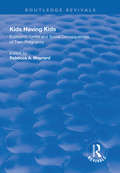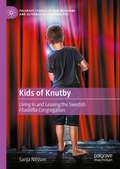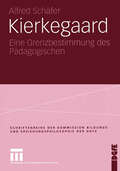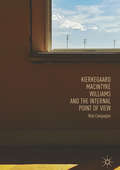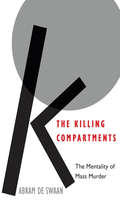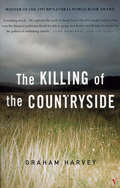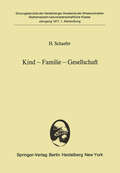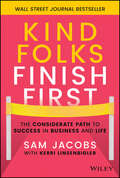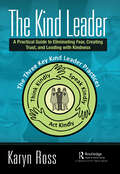- Table View
- List View
Kids Cybersecurity Using Computational Intelligence Techniques (Studies In Computational Intelligence Ser. #1080)
by Wael M. S. Yafooz Hussain Al-Aqrabi Arafat Al-Dhaqm Abdelhamid EmaraKids Having Kids: Economic Costs and Social Consequences of Teen Pregnancy (Routledge Revivals)
by Rebecca A. MaynardPublished in 1997. Adolescent mothers are more likely to encounter a variety of economic and social ills than women who delay childbearing until they are adults. This work is a comprehensive examination of the extent to which these undesirable outcomes are attributable to teen pregnancy itself rather than to the wider environment in which most of the pregnancies and the subsequent child-rearing take place. It also examines the consequences of adolescent pregnancy for the fathers of children, and even more importantly, for the children themselves.
Kids Having Kids: Economic Costs and Social Consequences of Teen Pregnancy (Routledge Revivals)
by Rebecca A. MaynardPublished in 1997. Adolescent mothers are more likely to encounter a variety of economic and social ills than women who delay childbearing until they are adults. This work is a comprehensive examination of the extent to which these undesirable outcomes are attributable to teen pregnancy itself rather than to the wider environment in which most of the pregnancies and the subsequent child-rearing take place. It also examines the consequences of adolescent pregnancy for the fathers of children, and even more importantly, for the children themselves.
Kids of Knutby: Living in and Leaving the Swedish Filadelfia Congregation (Palgrave Studies in New Religions and Alternative Spiritualities)
by Sanja NilssonThis book tells the story of the children and youth of the charismatic new religious commune Knutby Filadelfia in Sweden. It recounts the history of the congregation, which started out as a part of the Swedish Pentecostalmovement in 1921. In the 1990s, it developed into a new religion, when the congregation’s female pastor embraced the role of the Bride of Christ. The congregation became widely known in 2004 when one of its members was murdered by another member, the latter claiming to have been acting on orders from God. In 2018, the congregation dissolved after a few years of internal crisis.Sanja Nilsson provides rich empirical analysis of archival material and interviews with the congregation’s children and youth. The young informants’ personal perspectives on their own childhoods encompass narratives from their time inside the congregation, when they identified as members of a stigmatizedminority religion, as well as from the time after the dissolution of the group, when they identified asdefectors from what they came to view as a sectarian milieu.This work offers a comprehensive insight into the Knutby Filadelfia congregation, a group, that although notoriously charted by the media, has been hitherto unexplored by academics. It adds to the growing field of studies concerned with childhoods within new religions and expounds the dynamics of the defection process from the rarely applied perspective of children and youth themselves.
Kierkegaard: Eine Grenzbestimmung des Pädagogischen (Schriftenreihe der Kommission Bildungs- und Erziehungsphilosophie der DGfE)
by Alfred SchäferDass Menschen in sich selbst keinen Grund für ihre Handlungen und Urteile finden können, dass man sie (pädagogisch) gerade auf diese Grundlosigkeit des eigenen Selbst aufmerksam machen müsse, was man aber wiederum über eine direkte Ansprache nicht kann: solche Positionen haben Sören Kierkegaard bisher zu einem in der Pädagogik systematisch vernachlässigten Autor gemacht. Grenzreflexionen pädagogischer Möglichkeiten sind jedoch möglicherweise das, was der 'aufklärerischen' Pädagogik fehlt.
Kierkegaard, MacIntyre, Williams, and the Internal Point of View
by Rob CompaijenThis book takes the debate about the (ir)rationality of the transition to ethical life in Kierkegaard’s thought in a significantly new direction. Connecting the field of Kierkegaard studies with the meta-ethical debate about practical reasons, and engaging with Alasdair MacIntyre’s and Bernard Williams’ thought, it explores the rationality of the choices for ethical life and Christian existence. Defending a so-called ‘internalist’ understanding of practical reasons, Compaijen argues that previous attempts to defend Kierkegaard against MacIntyre’s charge of irrationality have failed. He provides a thorough analysis of such fundamental topics as becoming oneself, the ideal of objectivity in ethics and religion, the importance of the imagination, the power and limits of philosophical argument, and the relation between grace and nature. This book will be of great interest to Kierkegaard scholars in philosophy and theology, and, more generally, to anyone fascinated by the rationality of the transition to ethical life and the choice to accept Christianity.
Kierkegaard, MacIntyre, Williams, and the Internal Point of View
by Rob CompaijenThis book takes the debate about the (ir)rationality of the transition to ethical life in Kierkegaard’s thought in a significantly new direction. Connecting the field of Kierkegaard studies with the meta-ethical debate about practical reasons, and engaging with Alasdair MacIntyre’s and Bernard Williams’ thought, it explores the rationality of the choices for ethical life and Christian existence. Defending a so-called ‘internalist’ understanding of practical reasons, Compaijen argues that previous attempts to defend Kierkegaard against MacIntyre’s charge of irrationality have failed. He provides a thorough analysis of such fundamental topics as becoming oneself, the ideal of objectivity in ethics and religion, the importance of the imagination, the power and limits of philosophical argument, and the relation between grace and nature. This book will be of great interest to Kierkegaard scholars in philosophy and theology, and, more generally, to anyone fascinated by the rationality of the transition to ethical life and the choice to accept Christianity.
Kikuyu Women, The Mau Mau Rebellion, And Social Change In Kenya
by Cora Ann PresleyBased on rare oral data from women participants in the "Mau Mau" rebellion, this book chronicles changes in women's domestic reproduction, legal status, and gender roles that took place under colonial rule. The book links labour activism, cultural nationalism, and the more overtly political issues of land alienation, judicial control, and character
Kikuyu Women, The Mau Mau Rebellion, And Social Change In Kenya
by Cora Ann PresleyBased on rare oral data from women participants in the "Mau Mau" rebellion, this book chronicles changes in women's domestic reproduction, legal status, and gender roles that took place under colonial rule. The book links labour activism, cultural nationalism, and the more overtly political issues of land alienation, judicial control, and character
Kill the Body, the Head Will Fall: A Closer Look at Women, Violence, and Aggression
by Rene DenfeldThe outspoken, articulate, and brilliant author of The New Victorians debunks the persistent belief that women are inherently less aggressive and less violent than men and examines the concept of aggression in this myth-shattering, eye-opening work. Through research, interviews with experts, analysis, and her own experience in the boxing ring, Denfeld presents a revisionist view of women, aggression, and violence, and addresses such issues as why women commit child abuse and other crimes; why women often feel guilty and our of control when enraged; how female competition is often subverted into hidden, often vicious reals; and the intersection between sex and violence.
A Killer By Design: Murderers, Mindhunters, and My Quest to Decipher the Criminal Mind
by Ann Wolbert Burgess Steven Matthew Constantine'I think you have something here' I said, 'This could lead to a whole new way of understanding criminal behaviour. As far as I know no one's ever tried to figure out why serial killers kill. The implications are profound.' Haunting, heartfelt, and deeply human, Dr Ann Burgess's remarkable memoir combines a riveting personal narrative of fearless feminism and ambition, bone-chilling encounters with real-life monsters, and a revealing portrait of the ever-evolving US criminal justice system. A Killer By Design will inspire, terrify, and enlighten you in equal measure.It forces us to confront the age-old question 'What drives someone to kill, and how can we stop them?' 'Of all the colleagues I've worked with, Ann is one of the sharpest – and one of the toughest ... She taught us how to harness the chaos of serial killers' minds and helped us decipher the undecipherable. I'd recommend that everyone read A Killer By Design; not only is it a great page-turner, but it's about time Ann's story was heard' - JOHN E. DOUGLAS, former FBI criminal profiler and bestselling author of Mindhunter.
Killer Cities (Published in association with Theory, Culture & Society)
by Nigel ThriftKiller Cities uses a combination of social theory, polemic and close attention to empirical detail to tell the story of how and why cities cause mass animal death and, in the process, hasten the destruction of the planet. This book is not just a lament, however. It is an attempt to navigate out of this mess of planned and unplanned violence towards a world in which cities no longer act as killers but become aligned with the lives of other beings. It offers pragmatic ways of diminishing the death toll and changing mindsets without ever minimizing the dilemmas that inevitably will have to be faced. Killer cities can be rehabilitated so that they offer brighter paths towards the future - for animals, for human beings, and for the planet. A new urban geography could be within our grasp. Indeed, it has to be, for all of our sakes.
Killer Cities (Published in association with Theory, Culture & Society)
by Nigel ThriftKiller Cities uses a combination of social theory, polemic and close attention to empirical detail to tell the story of how and why cities cause mass animal death and, in the process, hasten the destruction of the planet. This book is not just a lament, however. It is an attempt to navigate out of this mess of planned and unplanned violence towards a world in which cities no longer act as killers but become aligned with the lives of other beings. It offers pragmatic ways of diminishing the death toll and changing mindsets without ever minimizing the dilemmas that inevitably will have to be faced. Killer cities can be rehabilitated so that they offer brighter paths towards the future - for animals, for human beings, and for the planet. A new urban geography could be within our grasp. Indeed, it has to be, for all of our sakes.
Killer Cities (Published in association with Theory, Culture & Society)
by Nigel ThriftKiller Cities uses a combination of social theory, polemic and close attention to empirical detail to tell the story of how and why cities cause mass animal death and, in the process, hasten the destruction of the planet. This book is not just a lament, however. It is an attempt to navigate out of this mess of planned and unplanned violence towards a world in which cities no longer act as killers but become aligned with the lives of other beings. It offers pragmatic ways of diminishing the death toll and changing mindsets without ever minimizing the dilemmas that inevitably will have to be faced. Killer cities can be rehabilitated so that they offer brighter paths towards the future - for animals, for human beings, and for the planet. A new urban geography could be within our grasp. Indeed, it has to be, for all of our sakes.
Killing African Americans: Police and Vigilante Violence as a Racial Control Mechanism
by Noel A. CazenaveKilling African Americans examines the pervasive, disproportionate, and persistent police and vigilante killings of African Americans in the United States as a racial control mechanism that sustains the racial control system of systemic racism. Noel A. Cazenave’s well-researched and conceptualized historical sociological study is one of the first books to focus exclusively on those killings and to treat them as political violence. Few issues have received as much conventional and social media attention in the United States over the past few years or have, for decades now, sparked so many protests and so often strained race relations to a near breaking point. Because of both its timely and its enduring relevance, Killing African Americans can reach a large audience composed not only of students and scholars, but also of Movement for Black Lives activists, politicians, public policy analysts, concerned police officers and other criminal justice professionals, and anyone else eager to better understand this American nightmare and its solutions from a progressive and informed African American perspective.
Killing African Americans: Police and Vigilante Violence as a Racial Control Mechanism
by Noel A. CazenaveKilling African Americans examines the pervasive, disproportionate, and persistent police and vigilante killings of African Americans in the United States as a racial control mechanism that sustains the racial control system of systemic racism. Noel A. Cazenave’s well-researched and conceptualized historical sociological study is one of the first books to focus exclusively on those killings and to treat them as political violence. Few issues have received as much conventional and social media attention in the United States over the past few years or have, for decades now, sparked so many protests and so often strained race relations to a near breaking point. Because of both its timely and its enduring relevance, Killing African Americans can reach a large audience composed not only of students and scholars, but also of Movement for Black Lives activists, politicians, public policy analysts, concerned police officers and other criminal justice professionals, and anyone else eager to better understand this American nightmare and its solutions from a progressive and informed African American perspective.
The Killing Compartments: The Mentality of Mass Murder
by Abram de SwaanThe twentieth century was among the bloodiest in the history of humanity. Untold millions were slaughtered. How people are enrolled in the service of evil is a question that continues to bedevil. In this trenchant book, Abram de Swaan offers a taxonomy of mass violence that focuses on the rank-and-file perpetrators, examining how murderous regimes recruit them and create what De Swaan calls the "killing compartments” that make possible the worst abominations without apparent moral misgiving, without a sense of personal responsibility, and, above all, without pity. De Swaan wonders where extreme violence comes from and where it goes—seemingly without a trace—when the wild and barbaric gore is over. And what about the perpetrators themselves? Are they merely and only the product of external circumstance? Or is there something in their makeup that disposes them to become mass murderers? Drawing on a wide range of disciplines, including sociology, anthropology, political science, history, and psychology, De Swaan sheds new light on an urgent and intractable pathology that continues to poison peoples all over the world.
Killing Happy Animals: Explorations In Utilitarian Ethics (The Palgrave Macmillan Animal Ethics Series)
by Tatjana VišakIs it acceptable to kill an animal that has been granted a pleasant life? This book rigorously explores the moral basis of the ideal of animal-friendly animal husbandry and sheds new light on utilitarian moral theory by pointing out the assumptions and implications of two different versions of utilitarianism, with surprising conclusions.
The Killing Of The Countryside
by Graham HarveyOver then past fifty years the British countryside has changed out of all recognition. A wide range of wildlife species are disappearing - victims of modern intensive farming, of pesticides and fertilisers and the sheer relentless pressure to maximise output from every hedge bank and field corner. It need not have happened. The loss of our wildlife and countryside has come about through a deliberate and sustained national policy, one that costs the British people 8 billion a year. The Killing of the Countryside is a devastating attack on modern British agricultural policy and practice and a plea for a return to natural cycles, an end to subsidies and the domination of agribusiness, and for a safe, sustainable farming system.Winner of the 1997 BP Natural World Book Award.
Kind: Zentrale theoretische Figuren und ihre empirische Erkundung (Kinder, Kindheiten und Kindheitsforschung #30)
by Anja Schierbaum Miriam Diederichs Kristina SchierbaumDer Band stellt zentrale Theoriefiguren der Kinder- und Kindheitsforschung zur Diskussion und führt historische, theoretische und empirische Beiträge aus Geschichts-, Sozial- und Erziehungswissenschaften zusammen. Gegenstand sind kindheitsbezogene Problemstellungen wie Agency, Chancengleichheit, Partizipations- und Ressourcengerechtigkeit, Wohlbefinden, Flucht, Migration, Kinderrechte und Kinderschutz. Darüber hinaus werden die Bedingungen des Aufwachsens und die Lebenslagen von Kindern mit Bezug zur Forschung mit Kindern und zu Kindheit(en) reflektiert.
Kind — Familie — Gesellschaft: Vorgelegt in der Sitzung vom 3. Juli 1976 (Sitzungsberichte der Heidelberger Akademie der Wissenschaften #1977 / 1)
by H. SchaeferKind Folks Finish First: The Considerate Path to Success in Business and Life
by Sam JacobsYou don't have to be ruthless to get ahead—kindness will get you there faster From the CEO of the Pavilion community, Sam Jacobs, Kind Folks Finish First weaves practical business lessons with fresh perspectives on how you can achieve success. The ideas in this book are backed by the author's personal experience building a nearly $200-million business rooted in kindness, reciprocity, and deeply held values. More than that, they're proven principles that have helped thousands reach their goals in every arena. In business, we've been told to never leave money on the table. Don't split the difference. You need to be ruthless in order to make it to the top. Kind Folks Finish First shows you that isn't the only path. Being a good person and earning money aren't mutually exclusive. Helping others isn&’t a sacrifice; it's a long-term strategy that can spur your success if only you're willing to take the exit ramp, reset your destination, and fuel your future with generosity. Walk through a proven process to discover what you really stand for Learn how to assume control of your life and how to leverage reciprocity to drive professional success. Align your personal life with your professional life Unlock your highest potential to create true happiness Anyone looking for a kinder, gentler, more values-driven and authentic way to succeed will love this book. The secret is finally getting out—kind people really do get ahead faster.
Kind Folks Finish First: The Considerate Path to Success in Business and Life
by Sam JacobsYou don't have to be ruthless to get ahead—kindness will get you there faster From the CEO of the Pavilion community, Sam Jacobs, Kind Folks Finish First weaves practical business lessons with fresh perspectives on how you can achieve success. The ideas in this book are backed by the author's personal experience building a nearly $200-million business rooted in kindness, reciprocity, and deeply held values. More than that, they're proven principles that have helped thousands reach their goals in every arena. In business, we've been told to never leave money on the table. Don't split the difference. You need to be ruthless in order to make it to the top. Kind Folks Finish First shows you that isn't the only path. Being a good person and earning money aren't mutually exclusive. Helping others isn&’t a sacrifice; it's a long-term strategy that can spur your success if only you're willing to take the exit ramp, reset your destination, and fuel your future with generosity. Walk through a proven process to discover what you really stand for Learn how to assume control of your life and how to leverage reciprocity to drive professional success. Align your personal life with your professional life Unlock your highest potential to create true happiness Anyone looking for a kinder, gentler, more values-driven and authentic way to succeed will love this book. The secret is finally getting out—kind people really do get ahead faster.
Kind ja, Ehe nein?: Status und Wandel der Lebensverhältnisse von nichtehelichen Kindern und Kindern in nichtehelichen Lebensgemeinschaften (DJI - Familien-Survey #7)
by Walter Bien Norbert F. SchneiderWie bei der Verteilung von Familienformen im allgemeinen haben die unter schiedlichen Gesellschaftssysteme der früheren BRD und DDR auch in Struktur und Leben nichtehelicher Lebensgemeinschaften ihre Spuren hinter lassen. Dies gilt auch, wenn sich der Blick auf nichteheliche Lebensgemein schaften mit Kindern richtet, eine Lebensform, die in der DDR viel häufiger war als in der BRD. Gemäß diesen unterschiedlichen Traditionen sind in den alten Bundesländern Paare mit ein- oder beidseitiger Scheidungserfahrungen häufiger und Partnerschaften lediger Eltern seltener als in den neuen Bundes ländern. Ebenfalls auf DDR-Tradition beruht der höhere Anteil von nichtehe lichen Lebensgemeinschaften in einem gemeinsamen Haushalt. Unter die Rubrik der Ost-West-Unterschiede fallen auch folgende Befunde: • In den neuen Bundesländern liegt der Anteil der häufiger als einmal monatlichen Kontakte insgesamt deutlich niedriger als in den alten Bun desländern; ob dies mit dem DDR-spezifischen Charakter nichtehelicher Lebensgemeinschaften zusammenhängt, als "nichteheliche Familien gemeinschaften" zu fungieren, erscheint nicht ausgeschlossen, bedarf aber weiterer Aufklärung. • Der Kontakt ehelich geborener Kinder zum anderswo wohnenden ge schiedenen oder getrenntlebenden Vater ist in den alten Bundesländern intensiver als der Kontakt nichtehelich geborener Kinder zu ihrem zur Zeit der Geburt mit der Mutter nicht verheirateten Vater außer Haus. "Kindorientierung" der Eheschließung in den alten Bundesländern geht demnach einher mit einer verbreiteten Indifferenz nichtehelicher Partner gegenüber ihren Kindern. In den neuen Bundesländern ist dieses Gefälle kaum zu spüren.
The Kind Leader: A Practical Guide to Eliminating Fear, Creating Trust, and Leading with Kindness
by Karyn RossKindness and leadership aren’t often synonymous. Ask someone to describe "good leadership" to you and you will hear many adjectives used: authentic, bold, challenging, charismatic, decisive, empowering, fearless, goal-oriented, humble, inspiring, original, passionate, role-model, strategic and transparent, to name of a few. And though there are many more that come to mind, kindness isn’t one of them. And here’s the problem with that. Leaders lead. And the way a leader leads – how they do what they do – influences those they lead. From the president of the country, to the president of a company, from middle managers, right down to front-line supervisors, what a leader models – how they think, speak and act – influences the people they lead. Leaders who think, speak and act unkindly give legitimacy and permission to those they lead to think, speak, and act in exactly the same unkind ways. Today, in a world where a leaders’ words and actions travel quickly through social media channels such as Twitter, their influence – unkind or kind – is amplified through repeated views and sharing. In an increasingly fragmented, polarized and divided world, we need leaders who will bring people together not divide them. Leaders who value and model cooperation and collaboration over competition. And who model ways to think kindly, speak kindly and act kindly. We need kindness to become synonymous with good leadership. So that when someone is asked to describe the traits of a good leader, kindness will be the first word that comes to mind. Essentially, the purpose of this book is to teach leaders how to lead with kindness so they can influence the people they lead to create kinder workplaces, organizations and the world. Each chapter contains a mixture of theory, case studies and reflections from leaders and the people they influence. As well, the book follows the fictional stories of Kay’La Janson and Kevin Landrell, as they become leaders in a failing organization that is ultimately turned around through kind leadership. Between chapters there are a series of practical exercises based on concepts presented in the previous chapter with space to record outcomes and reflections on the practice process. This book gives you a deep theoretical understanding of the importance of leading with kindness and also provides practical exercises for you to use to turn theory into practice. Because "change means doing things differently," and because we only really "learn by doing" to create kinder organizations, kinder communities and a kinder world, leaders must be able to begin practicing kindness right away. By the time you finish the book, you will feel confident in your ability to lead with kindness and also to address organizational problems at work, at home and in the community, with kindness.

